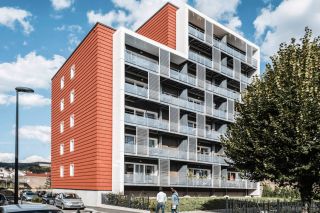
www.buildingsandcities.org/insights/commentaries/ieq-climate.html
Reconcile Healthy Indoor Environments and Climate Mitigation

By Christhina Candido, Rebecca Bentley and Samin Marzban (U Melbourne, AU)
Buildings are often referred to as a "second skin", providing sheltered infrastructure for working, playing, learning and living. People place trust in buildings to protect them and to provide safe indoor environments. Lessons from COVID-19 and recent extreme weather events are pertinent to COP-26, linking public health to the need for both mitigation and adaptation.
Indoor Environmental Quality (IEQ) can harm or protect human health in several ways e.g. poor Indoor Air Quality (IAQ) during the Australian bushfire season (Brambillla et al., 2021) and airborne transmission of COVID-19 during the pandemic (Moraska et al., 2020). The need to safe-proof buildings and IEQ in face of extreme weather events and COVID has become urgent and it is precipitating a re-think about building performance and operations. A key question is: how can we achieve healthy IEQ and reduce energy demand for space conditioning (heating and cooling)?
IEQ and workplaces
The mandatory working from home (WFH) due to the pandemic has highlighted the inadequacy of offices: e.g. the interruptions inherent in open plan (Marzban et al., 2021). Returning to a safe workplace is a concern as there are increased expectations from workers and organisations, especially when it comes to IAQ and the overall experience of workplaces delivered to people. But since only what gets measured, gets managed; this shift is likely to place emphasis on data and even more so on how building operations respond to data. An emphasis on high-performance workplaces is likely to shift from 'nice to have' to a 'must have'. However, the delivery of higher levels of performance often depends on mechanical systems and likely higher energy demands. Clearly, adaptation is a paramount concern, but this may directly conflict with the need to radically reduce energy demand and mitigate climate change.
The rekindled interest in humidity, ventilation rates, CO2 concentrations (just to cite a few from COVID) is increasing IAQ literacy and this is likely to push changes in expectations around conditions delivered indoors. COVID is a catalyst to rethink how buildings will cope with infections, extreme weather events but it risks exacerbating (HVAC) energy use due to increased ventilation demands. Conciliating energy efficiency, IAQ and health must become a clear focus in the post-COVID era for mechanical engineers. A challenge for the supply side is to embrace an ambitious agenda for increasing temperature set-points as well as leveraging data to fine-tune operations faster as a response to extreme weather events and higher fluctuations in occupancy (caused by increased hybrid ways of working).
IEQ and homes
More time spent at home as a result of COVID restrictions has amplified the need for high IEQ performance. Poor IEQ (including temperature, mould and damp) harms health. It is associated with respiratory illness, cardiovascular disease, poorer mental health and depression (e.g. Howden-Chapman et al., 2007) conditions which are major contributors to Australia's burden of disease (AIHW, 2021). Given that homes with poor IEQ tend to be in the rental sector and/or at the 'affordable' end of the housing market (Baker et al., 2019), this contributes to poorer health and generates health inequalities. This negative health impact is preventable, and inequalities shaped by the distribution of people within our housing systems can be reduced.
The increased energy demand from people spending more time in underperforming residential buildings creates more pressure on the electricity grid. A vicious cycle ensues: the more air-conditioning that is needed, the bigger the built environment's carbon footprint will be and vice versa. Residential buildings are ill-equipped to cope with extreme weather events, including bushfires, heat waves and cold snaps, which poses a threat to the health and wellbeing of occupants
Conclusions
Looking forward, ventilation in offices, schools and homes will become a critical tool for maintaining public health. Indeed, current statistical modelling used to inform Australia's (and many countries') COVID response strategies include the ventilation of offices and schools alongside vaccination, mask wearing and social distancing, as an effective means to reduce community transmission. Regulating the design and practices that influence air quality in homes, offices and schools will ensure that it is not only the well-off who will benefit from well designed and ventilated settings protecting them from airborne viruses.
New regulation and enforcement are needed to address health, comfort and energy in order to deliver high-performance environments in a variety of building types (homes, schools, offices, etc). The regulations have a responsibility to balance the trade-offs between maintaining health, providing comfort and climate mitigation (reducing energy demand).
Climate change is a health emergency and has direct impacts on IEQ. Implementing (and regulating) adaptation measures now for extreme events must now be a priority. Mechanical engineers and designers must seek adjusted and smarter options to deliver the new targets. The pandemic has laid bare the inadequacies of building operations and systems, now is time to leverage this momentum to address climate change.
References
AIHW (2021). Australian Burden of Disease Study 2018: key findings. Australian Institute of Health and Welfare. https://www.aihw.gov.au/reports/burden-of-disease/burden-of-disease-study-2018-key-findings/contents/key-findings
Baker, E., Lester, L., Beer, A., Bentley, R. (2019). An Australian geography of unhealthy housing. Geographical Research, 57(1), 40-51.
Brambilla, A., Candido, C., Sangiorgio, M., Gocer, O, Gocer, K. (2021). Can commercial buildings cope with Australian bushfires? An IAQ analysis. Building and Cities, 2(1), 583-598. https://doi.org/10.5334/bc.87
Howden-Chapman, P., Matheson, A., Crane, J.,Viggers, H., Cunningham, M., Blakely, T., et al. (2007). Effect of insulating existing houses on health inequality: cluster randomised study in the community. BMJ,334: 460. https://doi.org/10.1136/bmj.39070.573032.80
Marzban, S., Durakovic, I., Candido, C. & Mackey, M.(2021). Learning to work from home: experience of Australian workers and organizational representatives during the first Covid-19 lockdowns. Journal Of Corporate Real Estate, 23(3), 203-222. https://doi.org/10.1108/JCRE-10-2020-0049
Morawska, L., Tang, J.W., Bahnfleth, W., Bluyssen, P.M., Boerstra, A., Buonanno, G., et al. (2020). How can airborne transmission of COVID-19 indoors be minimised? Environment International, 142: 105832.
Latest Peer-Reviewed Journal Content
Designing for pro-environmental behaviour change: the aspiration–reality gap
J Simpson & J Uttley
Lifetimes of demolished buildings in US and European cities
J Berglund-Brown, I Dobie, J Hewitt, C De Wolf & J Ochsendorf
Expanding the framework of urban living labs using grassroots methods
T Ahmed, I Delsante & L Migliavacca
Youth engagement in urban living labs: tools, methods and pedagogies
N Charalambous, C Panayi, C Mady, T Augustinčić & D Berc
Co-creating urban transformation: a stakeholder analysis for Germany’s heat transition
P Heger, C Bieber, M Hendawy & A Shooshtari
Placemaking living lab: creating resilient social and spatial infrastructures
M Dodd, N Madabhushi & R Lees
Church pipe organs: historical tuning records as indoor environmental evidence
B Bingley, A Knight & Y Xing
A framework for 1.5°C-aligned GHG budgets in architecture
G Betti, I Spaar, D Bachmann, A Jerosch-Herold, E Kühner, R Yang, K Avhad & S Sinning
Net zero retrofit of the building stock [editorial]
D Godoy-Shimizu & P Steadman
Co-learning in living labs: nurturing civic agency and resilience
A Belfield
The importance of multi-roles and code-switching in living labs
H Noller & A Tarik
Researchers’ shifting roles in living labs for knowledge co-production
C-C Dobre & G Faldi
Increasing civic resilience in urban living labs: city authorities’ roles
E Alatalo, M Laine & M Kyrönviita
Co-curation as civic practice in community engagement
Z Li, M Sunikka-Blank, R Purohit & F Samuel
Preserving buildings: emission reductions from circular economy strategies in Austria
N Alaux, V Kulmer, J Vogel & A Passer
Urban living labs: relationality between institutions and local circularity
P Palo, M Adelfio, J Lundin & E Brandão
Living labs: epistemic modelling, temporariness and land value
J Clossick, T Khonsari & U Steven
Co-creating interventions to prevent mosquito-borne disease transmission in hospitals
O Sloan Wood, E Lupenza, D M Agnello, J B Knudsen, M Msellem, K L Schiøler & F Saleh
Circularity at the neighbourhood scale: co-creative living lab lessons
J Honsa, A Versele, T Van de Kerckhove & C Piccardo
Positive energy districts and energy communities: how living labs create value
E Malakhatka, O Shafqat, A Sandoff & L Thuvander
Built environment governance and professionalism: the end of laissez-faire (again)
S Foxell
Co-creating justice in housing energy transitions through energy living labs
D Ricci, C Leiwakabessy, S van Wieringen, P de Koning & T Konstantinou
HVAC characterisation of existing Canadian buildings for decarbonisation retrofit identification
J Adebisi & J J McArthur
Simulation and the building performance gap [editorial]
M Donn
Developing criteria for effective building-sector commitments in nationally determined contributions
P Graham, K McFarlane & M Taheri
Join Our Community

The most important part of any journal is our people – readers, authors, reviewers, editorial board members and editors. You are cordially invited to join our community by joining our mailing list. We send out occasional emails about the journal – calls for papers, special issues, events and more.
We will not share your email with third parties. Read more



Latest Commentaries
COP30 Report
Matti Kuittinen (Aalto University) reflects on his experience of attending the 2025 UN Conference of the Parties in Belém, Brazil. The roadmaps and commitments failed to deliver the objectives of the 2025 Paris Agreement. However, 2 countries - Japan and Senegal - announced they are creating roadmaps to decarbonise their buildings. An international group of government ministers put housing on the agenda - specifying the need for reduced carbon and energy use along with affordability, quality and climate resilience.
Building-Related Research: New Context, New Challenges
Raymond J. Cole (University of British Columbia) reflects on the key challenges raised in the 34 commissioned essays for Buildings & Cities 5th anniversary. Not only are key research issues identified, but the consequences of changing contexts for conducting research and tailoring its influence on society are highlighted as key areas of action.